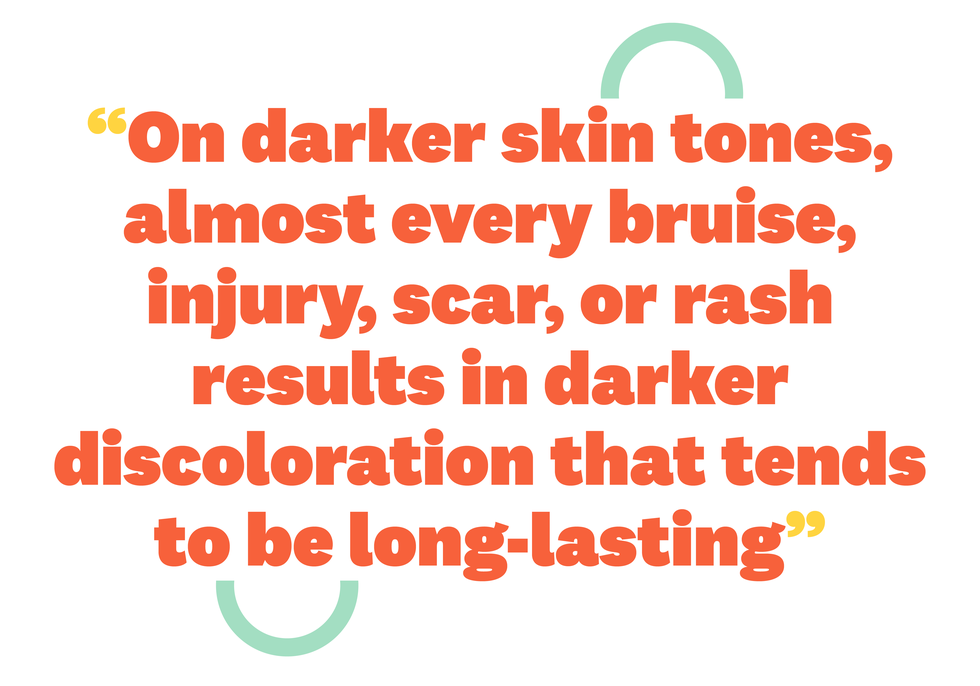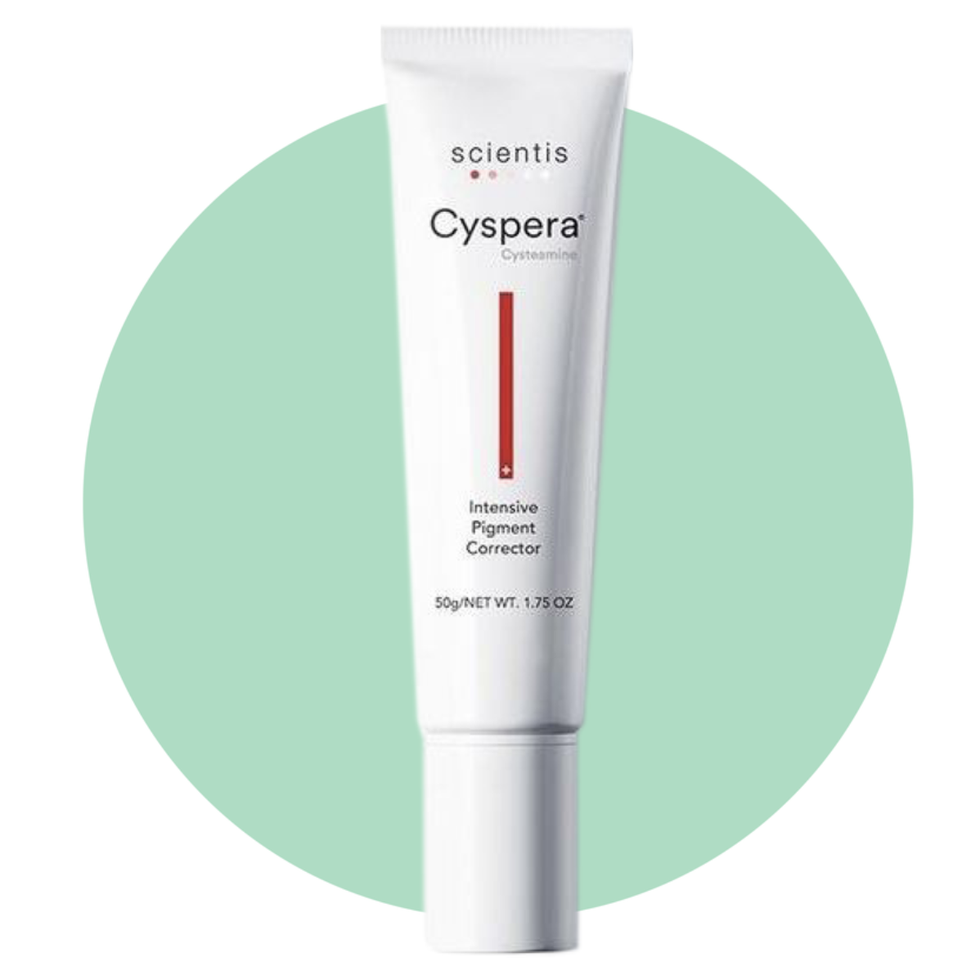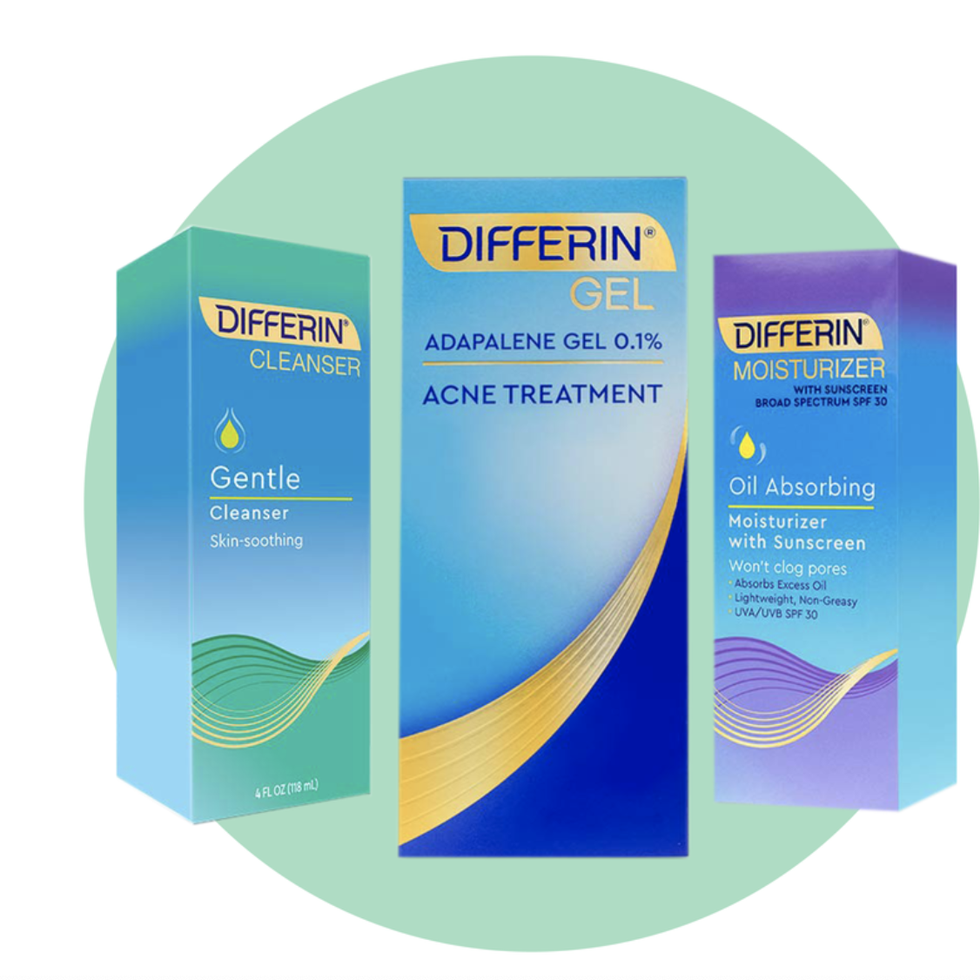If you’ve ever experienced that pesky dark spot, after a pimple begins to heal then you’ve probably experienced hyperpigmentation. To put it simply, hyperpigmentation is when the skin gets darker than one’s normal color in certain areas or patterns, says Chynna Steele Johnson, MD, a board-certified dermatologist at Steele Dermatology.
Hyperpigmentation can sometimes be referred to as blemishes, or sometimes even scars, but fortunately they aren’t really scars, explains Johnson. It can be caused by a variety of factors, but it happens when your skin cells start to produce too much melanin. That overproduction of melanin results in an uneven skin tone, or patches of skin that appear darker than the lighter areas of it.
Though hyperpigmentation can be annoying to deal with, the good news is that it is totally treatable and preventable, and actually quite normal. In most cases, it also isn’t a severe skin condition, and many times is more of a cosmetic issue. Lots of people with darker skin tones will deal with hyperpigmentation at some point in their lives.
The bad news is that it can often be challenging to treat and there are no quick fixes to it, says Peterson Pierre, MD, a board-certified dermatologist at the Pierre Skin Care Institute. “There are also no procedures that magically erase hyperpigmentation so be wary of unethical claims.”
But with a little patience and a few expert tips, you can start treating hyperpigmentation right at home. Here’s everything you need to know about hyperpigmentation and how it affects Black people, according to dermatologists.
What causes hyperpigmentation?
Pierre says hyperpigmentation has three main causes: sunlight, hormones, and inflammation. Each of these factors can contribute to extra pigment in their own way. Too much sun exposure can cause your skin to produce extra pigment that then causes your skin tone to appear blotchy and uneven. You can think about it similar to what happens when you experience tan lines, says Johnson. After getting a tan, you can very clearly seeing the difference in skin color between the parts of your body that weren't exposed to the sun and the ones that were. “The hyperpigmentation can show up as spotty and blotchy or in big broad patches,” says Johnson.
Hormones, like estrogen and progesterone, can also stimulate the overproduction of melanin, especially when the skin is exposed to the sun. “Hormones can cause a condition known as melasma that is dark blotchy pigmentation,” says Pierre.
Then there’s the hyperpigmentation that occurs when there’s some kind of trauma to your skin, like an acne scar or bug bite, says Pierre. Trauma can cause inflammation to the skin that can damage the pigment cells and cause them to leak out more pigment.
Does it affect Black people more severely in some ways?
Though hyperpigmentation appears in all skin types the same way—blotchy uneven skin tone—Pierre says that Black people are more prone to hyperpigmentation because they have a higher baseline of melanin content.
Hyperpigmentation can affect people of all ethnicities and skin colors after a skin injury, says Johnson, but people with darker skin tones are also more prone to dark spots after trauma. “When those melanocytes are activated by sun or trauma they have more melanin to make dark spots,” explains Johnson. “My patients of color who have any and all skin conditions not only suffer with the skin condition itself (acne, eczema, psoriasis, etc.), but they are also plagued by the long lasting dark spots that persist long after the acute issue is cleared up. It's really frustrating for them.”
How prevalent is hyperpigmentation in people with darker skin tones?
It’s incredibly common in Black people and other people with darker skin types, says Johnson. “Almost every bruise, injury, scar, rash results in darker discoloration that tends to be long-lasting (weeks-months depending on severity and location on the body).”
Johnson also adds some people with darker skin types are also less likely to use sunscreen, adding to the risk of hyperpigmentation. “Since people with darker skin types are less likely to sunburn, historically we have been less likely to consistently use sunscreen, so sun-induced patchy hyperpigmentation that results from years of sun exposure often develops. I often see this on the forehead and cheeks of many of my patients as they reach their 40's, 50's and 60’s,” explains Johnson.
How do you treat hyperpigmentation?
When it comes to treating hyperpigmentation, Pierre says that the goal is to lighten the excess pigment. To do this, the gold standard is using hydroquinone, so you’ll want to search for products that include that ingredient. The ingredient is a skin-bleaching chemical that work to lighten darker patches of skin.
Other ingredients that also work at lightening skin include include kojic acid, azelaic acid, vitamin C, and retinoids, says Pierre. You can also head to your dermatologist to see if you can get a prescription for a cream that includes a retin-A and hydroquinone combination. One product that he also recommends is Cyspera. It's an intensive pigment corrector that uses cysteamine, another skin-lightening agent, which Johnson also recommends. “It not only corrects hyperpigmentation, but improves the skin's radiance and promotes a very even and natural beautiful skin ”
Johnson also suggests looking for products with licorice extract, tranexamic acid, arbutin, soy, retinols, and alpha hydroxy acids. “These are quality ingredients and will help even out your skin tone when used consistently. You'll notice that your skin tone starts to look less spotty and things will be more even in tone over time.”
But how quickly your hypigmentation clears up depends on the severity of it and where the excess pigment is located, explains Johnson. “Spots on the face will clear up faster than areas further down on the body like the legs.”
If you want something that will work a little more quickly, you can opt for in-office procedures like chemical peels and certain lasers. But Pierre says these are best performed by board-certified dermatologists so that you can maximize your results and reduce the risk of any side effects.
Are there any ways to prevent it?
When it comes to hyperpigmenation, Johnson says that the best way to avoid it is to prevent trauma to the skin in the first place. “That means preventing acne or eczema breakouts in the first place, wearing sunscreen and practicing sun protection, and treating excess hair growth that could lead to hair bumps and hyperpigmentation.”
Johnson also suggests adding retinols and retinoids to your regular routine because they help with acne and hair bump prevention and also treat hyperpigmentation. One potent OTC product you can use for this is Differin, which Johnson says used to only be available by prescription.
The number one rule in skincare is also finding a good sunscreen, which can be tougher for Black people or people with dark skin since many of them don‘t blend into the skin well, says Johnson. Some good options you can consider include sunscreens with physical blockers like EltaMD or Isdin that are tinted and blend in pretty well, suggests Johnson. These can be added to your tinted moisturizer or liquid foundation to improve color match.
Don’t forget to use sun protection in addition to sunscreen, says Johnson. That includes wearing hats, not laying out in the sun, and wearing sunglasses.

Jasmine Gomez is the Commerce Editor at Women’s Health, where she cover the best product recommendations across beauty, health, lifestyle, fitness, and more. When she's not shopping for a living, she enjoys karaoke and dining out more than she cares to admit. Follow her @JazzeGomez.




